U.S. Department of Transportation
Federal Highway Administration
1200 New Jersey Avenue, SE
Washington, DC 20590
202-366-4000
FHWA Resource Center
Click here for the PDF Version of the Environmental Quarterly
To view PDF files, you need the Acrobat® Reader®
February/March 2012
INSIDE
• FHWA Announces Environmental Awards Program for Employees
• Social Media Changes Communications Landscape
• Stormwater Rulemaking in Progress
• Illinois Tribal Consultation Memorandum of Understanding Signed
• Emergency Consultation on California State Route 72 Results in Beneficial Actions for the Federally Endangered Arroyo Toad
• Livability and Sustainability Commonalities and Differences
• Environmental Calendar
LETTER FROM THE EDITOR
Dear Environmental Colleague,
Groundhog Day 2012 has passed and Punxsutawney Phil has seen his own shadow. If cherished folk beliefs--and the historic odds--are any indication, it looks like we should be prepared for six more weeks of winter. To ward off the chill, grab your favorite hot beverage and settle down with the new issue of The Environmental Quarterly.
This issue covers a variety of topics including a successful long-term tribal consultation effort in Illinois; an emergency endangered species consultation in California; and an update of EPA’s national rulemaking to strengthen its storm water program. Also, of special note, is the announcement of the new Annual Environmental Discipline Award program to support and recognize individual and team leadership and excellence within the FHWA Environmental Discipline. We hope that you will find this issue of useful and interesting.
As always, if you have stories you’d like to contribute or story ideas for this newsletter, let us know.
Sincerely,
Lamar Smith
Environment Technical Service Team Manager & Editor–in-Chief
Phone: (720) 963-3210
E-mail: lamar.smith@dot.gov
FHWA Announces Environmental Awards Program for Employees
The FHWA Environmental Discipline is an internal network of over 200 environmental professionals located in FHWA Division Offices, Headquarters, Resource Center, or Federal Lands Highway Division Offices throughout the country.
The purpose of the FHWA Environmental Discipline is to support its members working collaboratively within the discipline and across other FHWA disciplines, sharing resources, breaking down silos, and strengthening our abilities to deliver the FHWA Environmental Program.
The Environmental Discipline is led by the following three-member Champions Team:
• Lamar Smith, Team Leader for the FHWA Resource Center Environmental Technical Services Team
• Gerry Solomon, Director of the FHWA Office of Project Development and Environmental Review
• Brian Allen, Senior Environmental Engineer for the FHWA Western Federal Lands Highway Division
For the last several months, a team of FHWA employees has been assisting the Champions Team to develop an Annual Awards Program that is intended to support and recognize individual and team excellence within the FHWA Environmental Discipline. All FHWA employees who routinely work on NEPA/environmental issues in the transportation project development process are eligible to be nominated for an award. This includes environmental specialists, transportation engineers, operations engineers, transportation planners, team leaders, supervisors, and others who may have worked on FHWA environmental issues.
The purpose of the Annual Environmental Discipline Award is to support and recognize individual and team leadership and excellence within the FHWA Environmental Discipline.
The Awards Program was announced on January 18, 2012. Nominations will be accepted during February and March 2012. It is planned to announce the award recipients at the FHWA PEAR+C Conference in May 2012.
More information on the awards program is forthcoming. If you have any questions, you may contact one of the Environmental Discipline Champions Team members listed above.
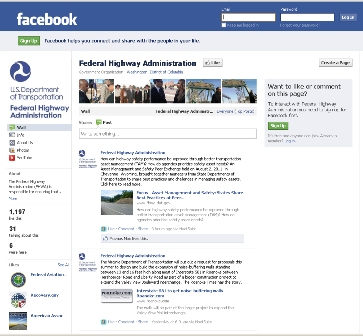
Screen capture of FHWA’s Facebook page.
Social Media Changes Communication Landscape
By Katiann Wong-Murillo, FHWA Resource Center; Jocelyn Jones, FHWA Resource Center; Tom White, FHWA Office of Public Affairs
Social Media tools have drastically changed the way people relate and connect to each other and the world around them. Since its creation 7 years ago, Facebook has gained more than 500 million active users worldwide, making it the number one social networking site on the Internet. YouTube hosts more than 80 million videos. Younger generations view email as passé – they interact via Facebook, text messages, and Twitter “Tweets”. Family photos are no longer collected into glossy albums, but shared across the Internet via image sharing sites like Flickr. It’s not whether or not the public, companies, Government agencies, and organizations will embrace Social Media — it’s already here. Businesses, organizations and agencies are advised to adapt to this advancing technology to better relate to their clients and customers in a more meaningful way.
But . . . what is it?
Five years ago, most of us hadn’t heard of Facebook. Ten years ago, many of us were just getting used to using email. We thought our telephone modems had “blazing speeds” at 56 kilobytes per second. Aversion towards Social Media tools is understandable. Change is often difficult to accept and adapt to, especially when it involves emerging technologies. But Social Media is not particularly complicated upon closer look.
According to Wikipedia, Social Media is defined as “a media for social interaction using highly accessible and scalable communication techniques. Social media is the use of Web-based and mobile technologies to turn communication into interactive dialogue.”
Perhaps the most important word in Social Media is “social” — that is, it’s interactive. It is no longer a one-way news source. Readers are encouraged to give feedback. And, feedback is not just defined as text, but rather images, video and links to other pages. It is a fluid form of communication.
Some sobering facts . . .
• Social networking accounts for 22 percent of all time spent online in the U.S.
• A total of 234 million people age 13 and older in the U.S. used mobile devices in December 2009.
• Social Media is not just a young person’s tool. The number of Social Media users age 65 and older grew 100 percent in 2010, with one in four people in that age group now part of a networking site.
• Facebook is now the primary method for communication by college students in the U.S; however 48 percent of current Facebook users are between 26 and 54 years of age.
• YouTube is the second most used Internet search engine – second only to Google.
New marketing tools beyond word-of-mouth
Using Social Media can build relationships quickly and easily with those we serve.
The key is to focus efforts to make Social Media work by celebrating successes and acknowledging contributors. Social Media is cost effective as it can engage the users by being influential and compel them to do some type of action. Social media can be immediate — an instantaneous response.
The goal is to engage and interact with an audience. Interesting content resonates with an audience, prompting them to interact. Social Media sites can become a resource and an authority where followers “go to” to find information. Social Media moderators can respond to feedback and answer questions while developing an accessible and responsive reputation.
Government agencies can use Social Media to inform multiple audiences about current and completed projects and initiatives. Other uses include recruiting potential employees, promoting events, and sharing photographs and video clips from recent events and speaking engagements. Social Media is a channel through which agency officials hope to engage readers, build interest, and seek public feedback and input.
Social Media . . . it’s not just for computers anymore
Many think of Social Media as residing on our desktop computer screens. This is simply not true. Social Media tools are available on smart-phones (both Apple iPhone and Google Android models), tablet computers, and even on some of our television sets (known as “smart TVs”). Once posted, information is available most anywhere at any time.
Next time . . .
In part two of this series—available next issue—we will discuss specific Social Media applications (e.g., Facebook, YouTube, Twitter, Flickr), the pros and cons of each, and the future of Social Media.
Stormwater Rulemaking in Progress
By Susan Jones, FHWA Office of Project Development & Environmental Review
Whenever it rains or snowmelt events occur and the precipitation runs over impervious surfaces and does not infiltrate into the ground, stormwater runoff is generated. Often, the runoff picks up sediments and pollutants along the way that could impact water quality if left untreated prior to discharge into water bodies.
The purpose of the National Pollutant Discharge Elimination System (NPDES) permit program is one of several strategies authorized by the Clean Water Act to protect surface water quality protection in the United States. The specific purpose of NPDES is to control point source discharges of pollutants such that the quality of receiving waters is maintained. A point source discharge is defined as any discernible, confined and discrete conveyance, such as a pipe, ditch, channel, tunnel, conduit, discrete fissure, or container. Stormwater discharges from roadside ditches or culverts are considered point sources and require a NPDES permit from the Environmental Protection Agency (EPA). Most states, with the exception of a few states, territories and on most land in Indian Country, are authorized to implement their own NPDES permit program. Construction activities over one acre in size and the storm sewer systems operated by a state, city, town, borough, county, parish, district, association, or other public body including transportation agencies are regulated under the NPDES Stormwater Program by Construction Stormwater Permits and Municipal Separate Storm Sewer (MS4) Permits, respectively. Any source of water pollution that does not meet the legal definition of "point source" is considered nonpoint source such as land runoff, precipitation, or atmospheric deposition.
In December 2009, the EPA initiated a national rulemaking to strengthen its stormwater program with plans to issue a draft by December 15, 2011 and have it finalized by November 2012. In August 2010, EPA sent six questionnaire instruments including a Transportation-Related MS4 Questionnaire designed to collect information from: regulated MS4s, non-regulated MS4s, Transportation MS4s, and NPDES Permit Authorities. The questionnaires were sent to a statistically-sampled subset of these facilities, 608 regulated MS4s, 84 regulated Department of Transportation MS4s and 932 federally non-regulated MS4s. Transportation-Related MS4 questionnaire can be viewed at: http://www.epa.gov/npdes/pubs/Final%20Transportation%20Related%20MS4%20Survey_WM.PDF and http://www.epa.gov/npdes/pubs/faq_transms4_icr.pdf
The questionnaires are part of EPA’s Information Collection Request (ICR) and the responses will serve to inform EPA regarding a possible stormwater rulemaking proposal. A fact on the Stormwater ICR can be found at: http://www.epa.gov/npdes/pubs/icr_factsheet_questionnaire.pdf The EPA is in the process of reviewing and analyzing the results of the questionnaires for this rulemaking.
The Transportation-Related MS4 Questionnaire requested information on the following:
• Stormwater conveyance (including direct discharge) within the MS4 jurisdiction;
• Specific stormwater program components (e.g., outreach, recordkeeping, training)
• and extent of coverage;
• Extent of new and redevelopment projects and MS4 oversight (e.g. site plan review);
• Current MS4 stormwater management requirements, including specific or numeric long term stormwater discharge standards for new and redevelopment activities;
• Local ordinances or other regulatory mechanisms that conflict with or encourage long term stormwater retention practices;
• Long term stormwater controls and practices installed, maintained and whether cost and/or performance data are available;
• Current capacity, budget, and funding sources for implementing, enforcing, maintaining and monitoring existing stormwater program; and
• Stormwater capital improvement plans and/or requirements (including retrofit of existing property).
Transportation agencies have been placed under the MS4 permitting structure largely for regulatory expediency. DOTs hope this rulemaking will reexamine the practice of placing a DOT program in a traditional MS4 permit framework because DOTs do not fit well within the traditional MS4 general permit framework. For instance, in comparison to municipalities, DOTs cannot enact ordinances or other regulatory mechanisms. Linear transportation systems often stretch for many miles, and cross numerous waterways, watersheds, and jurisdictions. Transportation storm conveyance systems often discharge stormwater and associated pollutants that originate outside of the transportation right-of-way.
EPA has developed a separate website on road-related MS4s at http://cfpub.epa.gov/npdes/stormwater/municroads/home.cfm that includes DOT-specific stormwater information, technical studies, a list of state DOT stormwater websites, and case studies. EPA will use this information to evaluate the incremental costs and impacts on Transportation MS4s.
Additional areas this rulemaking may address include:
• Developing performance standards from newly developed and redeveloped sites to better address stormwater management as projects are built;
• Exploring options for expanding the protections of the municipal separate storm sewer systems (MS4) program;
• Evaluating options for establishing and implementing a municipal program to reduce discharges from existing development;
• Establishing a single set of minimum measures requirements for regulated MS4s.
• Exploring options for establishing specific requirements for transportation facilities; and
• Evaluating additional provisions specific to the Chesapeake Bay watershed.
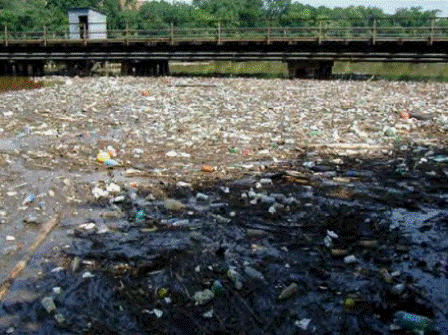
Photo of a District of Columbia receiving water impaired by trash. DOT has no enforcement authority of local litter ordinance. (Photo by DDOT and DDOE.)
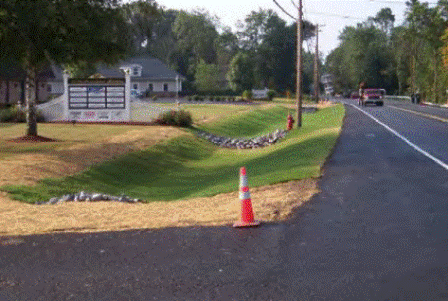
Photo of Swale in New York State. The design was limited by right-of-way and for safety. Some pollutant sources originate from outside of the DOT right-of-way. (Photo by NYSDOT.)
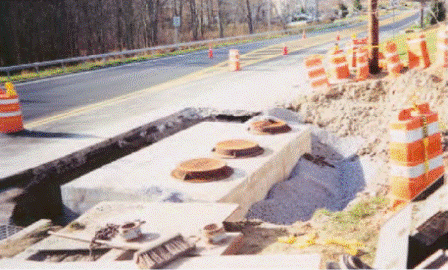
Photo of a vault in New York State. Maintenance requires lane closure. (Photo by NYSDOT.)
ILLINOIS TRIBAL CONSULTATION MEMORANDUM OF UNDERSTANDING SIGNED
By Jan Piland, FHWA Illinois Division
After 2 workshops (November 2008 and July 2009) and 3 years of collaboration among agencies and Tribes, we have collectively produced a Memorandum of Understanding (MOU) among the Federal Highway Administration (FHWA), the Illinois Department of Transportation (IDOT), the Illinois State Historic Preservation Officer (SHPO) and federally recognized Tribes with an interest in Illinois lands. The FHWA Illinois Division, IDOT, and the SHPO signed the MOU August 31, 2011, and it was sent to all 26 Tribes who have expressed an interest in Illinois. The first Tribal signature was received from the Iowa Tribe of Kansas and Nebraska, who signed September 19, 2011. Although the MOU was officially effective on the date of that first Tribal signature, IDOT and FHWA have been operating under its principles since its draft stages when the electronic Project Notification System (PNS) was developed by IDOT and its intergovernmental partner, the Illinois State Archaeological Survey (ISAS). The PNS won an Exemplary Human Environment Initiative (EHEI) award in 2010 “for helping to improve opportunities for Tribal participation in highway project development”, sending hundreds of notifications to Tribes since 2009 of transportation projects for which an archaeological survey has been requested. If Tribes so choose, they can access project information including a 7.5 minute quadrangle map showing the proposed project location and any known archaeological sites. They may provide comments through the PNS, or request to be a consulting party. FHWA and IDOT assess the comments and requests, and follow up with Tribal consultation as appropriate.
Through the workshops and MOU development, the FHWA Illinois Division and IDOT began to work closely with the Tribes, developing a mutual understanding of each others’ mission and interests. This understanding has deepened into relationships as opportunities to consult on projects have arisen.
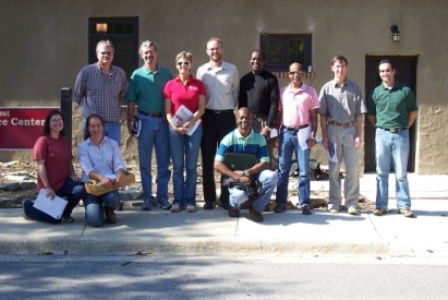
Photo of the Miami Nation Tribal Historic Preservation Officer George Strack visits North Branch of the Chicago River Proposed Bicycle Trail Extension,
Cook County Forest Preserve, Illinois. (Photo by the Illinois State Archaeological Survey.)
Intense and comprehensive negotiations among agencies and Tribes on the New Mississippi River Bridge (NMRB) in East St. Louis resulted in some major roadside drainage design modifications along proposed I-70 that helped to preserve remnants of an ancient earthen monument and burial area, “Feature 2000", in the right-of-way. The NMRB archaeological work won a 2011 Environmental Excellence Award “for excellence in Cultural and Historical Resources”, demonstrating IDOT’s “deep commitment to preserving heritage sites while efficiently improving our Nation’s transportation infrastructure.”
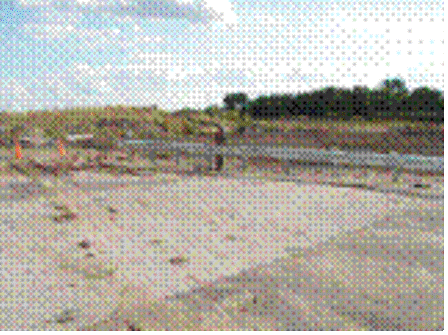
Photo of the NMRB feature 2000 Preservation Area depicting a 42” waterline that was relocated to accommodate preservation goals. (Photo by the Illinois State Archaeological Survey.)
IDOT and ISAS archaeologists have been extremely welcoming and open with information to the Tribes during project visits, strengthening the trust among the entities. We have received multiple positive comments about the PNS and the MOU, and have had excellent interactions with the Tribes during consultations.
FHWA and IDOT are optimistic about Tribal consultation in Illinois. We will continue to build on the foundation of trust we have developed and to make efforts to broaden our relationships with the Tribes.
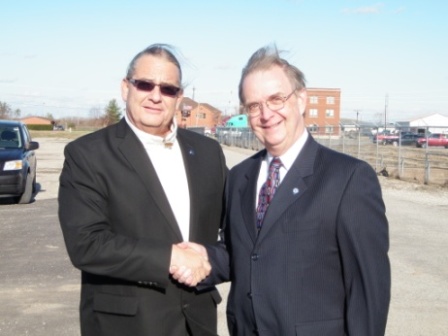
Photo of Osage Nation Assistant Chief BigHorse with FHWA Illinois Division Administrator Norm Stoner at Feature 2000 Preservation Area. (Photo by the Illinois State Archaeological Survey.)
Emergency Consultation on California State Route 74 Results in Beneficial Actions for the Federally Endangered Arroyo Toad
By Sally Brown, U.S. Fish and Wildlife Service
On January 18, 2010, a significant rainstorm occurred in an area of unincorporated Orange County along State Route 74 (SR-74) where a recent fire event had denuded the ridgeline. In addition, recent disking had occurred within an agricultural field adjacent to the roadway and below the burned area. This resulted in a 0.25 mile-long mudslide across SR-74 and closure of the freeway. Emergency work was required to clear mud and debris from the roadway and to repair significant erosion to prevent roadway failure at several locations through placement of rock slope protection and installation of new culverts. The emergency work area was located adjacent to San Juan Creek, within critical habitat for the federally endangered arroyo toad (Anaxyrus californicus).
The California Department of Transportation (Caltrans) contacted the United States Fish and Wildlife Service (USFWS) in the early stages of the emergency. This allowed the USFWS to offer recommendations on how to minimize the effects of the emergency response action on the arroyo toad and its critical habitat, such as having a biological monitor on-site, and stockpiling loose friable soils that arroyo toads may burrow into out of toad habitat, or surrounding the stockpiles with sediment fencing to exclude toads. The project resulted in minimal permanent impacts to approximately 0.35 acres of arroyo toad critical habitat. To offset these impacts, coordination between Caltrans and USFWS in the early stages of the emergency resulted in the recommendation that funding be provided to continue ongoing arroyo toad predator removal work in the adjacent habitat.
The arroyo toad has been affected by predation and competition from invasive animal species including the American bullfrog (Lithobates catesbeiana), red swamp crayfish (Procambarus clarkii), and African clawed frog (Xenopus laevis). The U. S. Geological Survey has produced data during recent predator eradication efforts along the Santa Margarita River estimating that during the breeding season 120 adult arroyo toads are being eaten by bullfrogs per kilometer of river per month, with each bullfrog consuming an average of 12 arroyo toads per month during the breeding season.
Arroyo toad predator removal work conducted in San Juan Creek to offset the impacts of a prior road project along SR-74 had resulted in the removal of approximately 12,847 bullfrog adults, metamorphs, and tadpoles, 11,233 crayfish, and 21 African clawed frogs over the course of three years (2007-2009). During the initial 2007 surveys, 7 arroyo toads were seen with no breeding behavior. In 2008, 36 arroyo toads were seen and breeding behavior (calling) was observed. In 2009, arroyo toad numbers were reduced to 11, with no breeding behavior, possibly due to dry conditions (Bonterra Consulting 2009). This marked the completion of the survey and predator removal work required for the prior road project.
To offset the impacts of the emergency work, the arroyo toad predator removal effort was continued for a year, through June of 2011. In 2010, an additional 1,444 crayfish and 54 bullfrogs were removed (LSA Associates, Inc. 2011a) and arroyo toad breeding was observed in the treated reach of San Juan Creek for the first time since the predator removal work and associated surveys began (LSA Associates, Inc. 2011b). Surveys documented a few hundred arroyo toad tadpoles and several dozen arroyo toad metamorphs (i.e., juveniles) (LSA Associates, Inc. 2011b). A second emergency, which occurred as a result of flood damage along SR-74 in December of 2010, has funded the continuation of the predator removal work through June of 2012. Initial results from 2011 include the observation of arroyo toad egg masses (LSA Associates, Inc. 2011b).
Literature Cited:
Bonterra Consulting. 2009. Results of 2009 Focused surveys for the arroyo toad within San Juan Creek in the Cleveland National Forest, Orange County, California. 11+ pp.
LSA Associates, Inc. 2011a. Invasive Species Removal Summary Report 2010-2011 for the Upper SR-74 (Ortega Highway), Orange County, California; Caltrans EA No. 0L-4603, Task Order 21, Amendment 2.
LSA Associates, Inc. 2011b. Results of 2010 Non-Focused Surveys and 2011 Focused Surveys for the Arroyo Toad Within San Juan Creek in the Cleveland National Forest, Orange County, California; Caltrans EA No. 0L-4603, Task Order 21, Amendment 2.
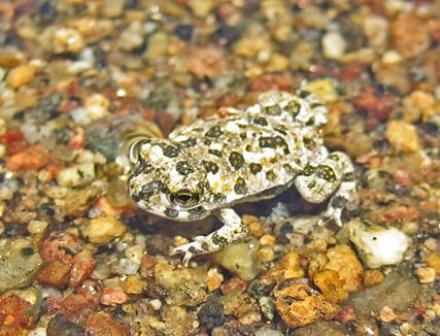
Photo of a juvenile arroyo toad. (Photo by Chris Brown, USGS.)
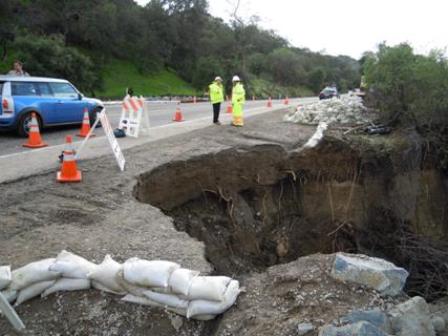
Photo showing erosion and slope failure at SR-74 emergency slope and culvert repair project, Orange County 01-27-09, Federally endangered arroyo toad habitat. (Photo by Sally Brown, USFWS.)
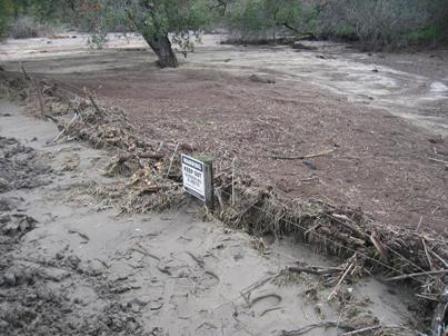
Photo depicting mudflow at SR-74 emergency slope and culvert repair project, Orange County, 12-2010. (Photo by Caltrans D12 Maintenance and Engineering Department.)
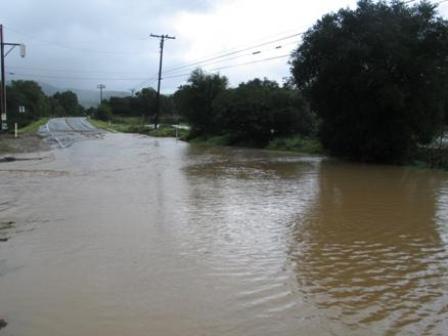
Photo of flooding at SR-74 emergency slope and culvert repair project, Orange County, 12-2010. (Photo by Caltrans D12 Maintenance and Engineering Department.)
Livability and Sustainability Commonalities and Differences
By Jonathan Crum, FHWA PA Division & Shana Baker, FHWA Office of Human Environment, Livability Team
Since the inception of the U.S. Department of Housing and Urban Development, the U.S. Department of Transportation and the U.S. Environmental Protection Agency Interagency Partnership for Sustainable Communities, there has been much discussion amongst transportation practitioners about the difference between livability and sustainability. Although the terms have been used interchangeably, there are some key differences between the two.
Livability focuses on detailed strategies to improve travel choices and accessibility, lower transportation and housing cost, and support neighborhoods and communities. Livability is about leveraging the quality, location, and type of transportation facilities and services available to help achieve broader community goals such as access to a variety of jobs, community services, affordable housing, quality schools, and safe streets. Sustainable Communities* refers to places that balance their economic and natural assets so that the diverse needs of communities can be met.
Sustainability is traditionally described as meeting the needs of the present without compromising the ability of future generations to meet their own needs. FHWA’s approach to sustainability and highways is broader than livability, focusing on the three pillars—social, economic, and environmental –of the “triple bottom line” upon which sustainability is based. It includes livability principles and considerations, but also addresses a broader array of techniques, initiatives, and programs and includes the development of tools for transportation agencies to assess and consider sustainability characteristics of a highway or roadway project throughout its lifecycle.
The challenge of distinguishing between the two can be complicated in practice given that transportation solutions that support both concepts are likely to be similar. Solutions may include addressing road safety and capacity issues, enhancing the natural environment, strategically connecting modes, and using approaches such as Transportation Demand Management and system Management and Operation strategies to maximize the efficiency of transportation investments.
Although there are key differences between the two there are several key commonalities. Both livability and sustainability address issues of:
Social equity from which all individuals have equal access to public facilities and there is, to the extent practical, the safe and efficient movement of people and goods which leads to community improvements, overall;
Human health by providing for multi-modal transportation options, including non-motorized transportation which not only improves air quality, but encourages a more active lifestyle;
Environmentally friendly travel options through transportation planning and project development that encourages options for long-term economic and social viability of communities, a healthier diverse population, and a cleaner environment; and
Economic development through the integration of land use into transportation planning and the development of innovative, cost-effective solutions that support the communities.
In the end, regardless of whether transportation solutions fall under the category of ‘livability’ or ‘sustainability’, the key is to develop solutions that consider how the proposed projects fit into the context of the communities and the resultant short and long-term benefits and/or impacts to the environment. Currently, metrics are being developed to evaluate livability and sustainability into transportation programs. FHWA is developing a handbook to help transportation agencies develop and define performance measures appropriate to creating, developing and enhancing livable communities. With regard to sustainability, FHWA is developing a voluntary self-evaluation tool (INVEST) that helps transportation agencies to integrate sustainability into their highway projects and programs, from planning and project development through design, construction, operations and maintenance. It is through these evaluation tools that practitioners will be able to further gauge whether projects promote livable communities and sustainable transportation. After all, the incorporation of elements from both livability and sustainability is integral when developing place-based transportation strategies.
More information about livability and sustainability can be found on the Livability website and the Sustainable Highways Invest Tool website. A follow up article on specific examples of Livability and Sustainability put into practice will be in a future newsletter.
*Sustainable Communities is a term commonly used under the Partnership for Sustainable Communities which equates to Livability or Livable Communities in most cases.
What's Going On?
April 2012
Apr. 18-22
Society for American Archaeology 77th Annual Meeting
Memphis, TN
June 2012
June 5-7
2nd National Conference on Engineering & Ecology for Fish Passage
University of Amherst, Massachusetts
www.fishpassageconference.com
September 2012
Sept. 9-12
Northeastern Transportation & Wildlife Conference, Hosted by Maine DOT
Location TBD
CONTACT INFORMATION:
Federal Highway Administration
Resource Center
Editor-in-Chief
Lamar Smith, Environment Technical Service Team Leader
Phone: (720) 963-3210/Fax: (720) 963-3232
E-mail: lamar.smith@dot.gov
Editorial Board Members:
Brian Smith, Biology/Water Quality Specialist
Phone: (708) 283-3553/Fax: (708) 283-3501
E-mail: brian.smith@dot.gov
Stephanie Stoermer, Environmental Program Specialist/Archeologist
Phone: (720) 963-3218/Fax: (720) 963-3232
E-mail: stephanie.stoermer@dot.gov
Deborah Suciu-Smith, Environmental Program Specialist
Phone: (717) 221-3785/Fax: (717) 221-3494
E-mail: deborah.suciu.smith@dot.gov
Melissa Toni, FHWA NY Division
Phone: (518) 431-4125 x 227
E-mail: melissa.toni@dot.gov
Production Schedule:
Due to our Quarterly publication schedule, all article submissions for future issues are due to the Editor-In-Chief by the 10th of March, June, September, and/or December
Getting the news:
*If you would like to receive this newsletter electronically, please send your email address to: marie.roybal@dot.gov